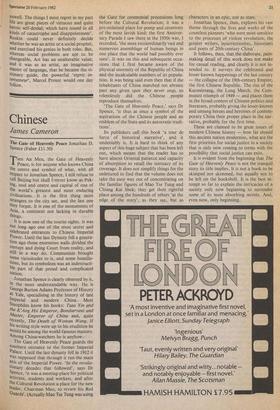Chinese
James Cameron
The Gate of Heavenly Peace Jonathan D. Spence (Faber £11.50) Tien An Men, the Gate of Heavenly Peace, is for anyone who knows China the centre and symbol of what, with all respect to Jonathan Spence, I still refuse to Call Beijing but shall forever know as Pek- ing, soul and centre and capital of one of the world's greatest and most enduring civilisations. It is the first thing most strangers to the city see, and the last one they forget. It is one of the monuments of Asia, a continent not lacking in durable things.
It is now one of the tourist sights. It was not long ago one of the most secret and Celebrated entrances to Chinese Imperial Power. Until the last Dynasty fell a genera- tion ago those enormous walls divided the corrupt and dying Court from reality, and still in a way do. Communism brought some vicissitudes to it, and some humilia- tions, but its symbolism was an indestructi- ble part of that proud and complicated nation.
Jonathan Spence is clearly obsessed by it, in the most understandable way. He is George Burton Adams Professor of History at Yale, specialising in the history of late Imperial and modern China. Most Sinophiles know his books: Tsao Yin and the K'Ang Hsi Emperor, Bondservant and Master, Emperor of China and, quite recently, The Death of Woman Wang. If his writing style were up to his erudition he would be among the world-famous masters. Among China-watchers he is anyhow.
The Gate of Heavenly Peace guards the southern entrance to the former Imperial Palace. Until the last dynasty fell in 1912 it was supposed that through it ran the main axis of the Imperial Power. 'In the revolu- tionary decades that followed', says Dr Spence, 'it was a meeting-place for political activists, students and workers, and after the Cultural Revolution a place for the new leader, Chairman Mao, to review his Red Guards'. (Actually Mao Tse Tung was using the Gate for ceremonial processions long before the Cultural Revolution; it was a pre-ordained place for pomp and ceremony of the most lavish kind; the first Anniver- sary Parade I saw there in the 1950s was, I recorded, 'the most extraordinarily vast and numerous assemblage of human beings in one place that the world had possibly ever seen'. It was on this and subsequent occa- sions that I first became aware of the physical enormity of the Republic of China and the incalculable numbers of its popula- tion. It was being said even then that if the inhabitants of China marched ten abreast past any given spot they never stop, so relentlessly did the Chinese people reproduce themselves.
`The Gate of Heavenly Peace,' says Dr Spence, 'is thus at once a symbol of the aspirations of the Chinese people and an emblem of the State and its autocratic tradi- tions'.
Its publishers call this book 'a tour de force of historical narrative', and it undeniably is. It is hard to think of any aspect of this huge subject that has been left out, which means that the reader has to have almost Oriental patience and capacity of absorption to recall the intricacy of its coverage. It does not simplify things for the unlettered to find that the volume does not take the easy way out of concentrating on the familiar figures of Mao Tse Tung and Chiang Kai Shek; they get their rightful place among the hundreds of others 'at the edge of the story', as they say, but as characters in an epic, not as stars.
Jonathan Spence, then, explores his vast theme through the lives and works of the countless pioneers 'who were most sensitive to the processes of violent revolution, the greater writers, insurrectionists, historians and poets of 20th-century China'.
It follows, then, that the elaborate, pain- staking detail of this work does not make for casual reading, and clearly it is not in- tended to. It surveys the celebrated and lesser-known happenings of the last century — the collapse of the 19th-century Empire, the first Chinese Republic. The rise of the Kuomintang, the Long March, the Com- munist triumph of 1949 — and places them in the broad context of Chinese politics and literature, probably giving the lesser-known and unsung heroes and heroines of contem- porary China their proper place in the nar- rative, probably for the first time.
These are claimed to he great issues of modern Chinese history — how far should this ancient nation modernise, what are the first priorities for social justice in a society that is only now coming to terms with the possibility that social justice can exist.
It is evident from the beginning that The Gate of Heavenly Peace is not the tranquil • story its title implies. It is not a book to be skimped nor skimmed, but equally not to be left on the bookshelf. it is the best at- tempt so far to explain the intricacies of a society only now beginning to surrender some of its most absorbing secrets. And, even now, only beginning.






































 Previous page
Previous page